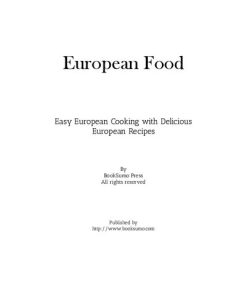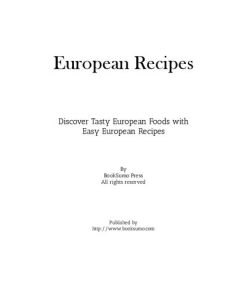Europe: From Portugal to German, Enjoy Delicious Ethnic Cooking with Easy European Recipes 2nd Edition by Booksumo Press 9780192511188 0192511181
$50.00 Original price was: $50.00.$25.00Current price is: $25.00.
Europe: From Portugal to German, Enjoy Delicious Ethnic Cooking with Easy European Recipes 2nd Edition Booksumo Press – Ebook Instant Download/Delivery ISBN(s): 9780192511188, 0192511181

Product details:
- ISBN 10:0192511181
- ISBN 13: 9780192511188
- Author: Booksumo Press
From Proto-Indo-European to Proto-Germanic
Table contents:
A note on transcription
1: Introduction
1.1 On this edition
1.2 General introduction to the first edition
2: Proto-Indo-European
2.1 Introduction
2.2 PIE phonology
2.2.1 PIE obstruents
2.2.2 PIE sonorants and high vowels
2.2.3 PIE nonhigh vowels
2.2.4 PIE phonological rules
2.2.4 (i) Ablaut and laryngeals
2.2.4 (ii) Syllabification of sonorants
2.2.4 (iii) Some rules affecting obstruents
2.2.4 (iv) Auslautgesetze
2.2.5 PIE accent
2.3 PIE inflectional morphology
2.3.1 PIE inflectional categories
2.3.2 Formal expression of inflectional categories
2.3.3 PIE verb inflection
2.3.3 (i) Verb stems: from derivation to inflection
2.3.3 (ii) The Nuclear IE mood suffixes
2.3.3 (iii) Endings
2.3.3 (iv) Nonfinite forms
2.3.3 (v) The architecture of Core IE verb paradigms
2.3.3 (vi) Sample Proto-Central IE verb paradigms
2.3.4 PIE noun inflection
2.3.4 (i) Endings
2.3.4 (ii) Accent and ablaut patterns
2.3.4 (iii) Sample Proto-Central IE noun paradigms
2.3.5 PIE adjective inflection
2.3.6 The inflection of other PIE nominals
2.3.6 (i) PIE numerals
2.3.6 (ii) PIE `pronominal´ inflection
2.3.6 (iii) PIE personal pronouns
2.4 PIE derivational morphology
2.4.1 Compounding
2.4.2 PIE derivational suffixes
2.4.2 (i) PIE noun-forming suffixes
2.4.2 (ii) PIE adjective-forming suffixes
2.4.2 (iii) Derivational suffixes that eventually became inflectional
2.5 PIE syntax
2.6 The PIE lexicon
3: The development of Proto-Germanic
3.1 Introduction
3.1.1 Linguistics and archaeology
3.2 Regular sound changes
3.2.1 The elimination of laryngeals, and related developments of vowels
3.2.1 (i) Cowgill´s Law
3.2.1 (ii) The loss of laryngeals word-initially and next to nonhigh vowels
3.2.1 (iii) Osthoff´s Law
3.2.1 (iv) Other developments of laryngeals
3.2.1 (v) The effect of laryngeal developments on ablaut
3.2.2 Changes affecting sonorants
3.2.2 (i) Syllabic sonorants
3.2.2 (ii) Auslautgesetze affecting nasals
3.2.3 Changes affecting obstruents
3.2.3 (i) Coronal clusters
3.2.3 (ii) The reorganization of dorsal stops
3.2.4 Grimm´s Law and Verner´s Law
3.2.4 (i) Grimm´s Law
3.2.4 (ii) Verner´s Law and the elimination of contrastive accent
3.2.4 (iii) The elimination of *gw
3.2.4 (iv) Related changes of obstruents
3.2.4 (v) Two disputed sound changes
3.2.5 Sievers´ Law and unstressed syllables
3.2.5 (i) The apocope of nonhigh short vowels
3.2.5 (ii) Developments of Sievers´ Law
3.2.5 (iii) The raising of unstressed *e; unstressed *ew
3.2.5 (iv) Raising of *e by following high front vocalics
3.2.6 Loss of *j, *w, and *ə; *uj *ij; miscellaneous consonant changes
3.2.6 (i) Loss of *j and *w
3.2.6 (ii) Loss of surviving *ə
3.2.6 (iii) Assimilation and excrescence in consonant clusters
3.2.6 (iv) Loss of word-final *t
3.2.7 Other changes of vowels
3.2.7 (i) Mergers of nonhigh back vowels
3.2.7 (ii) Late developments of *VNC-sequences
3.2.8 Chronological overview
3.3 Restructurings of the inflectional morphology
3.3.1 The restructuring of the verb system
3.3.1 (i) The semantic development of the Nuclear IE perfect (stative) and the loss of the aorist in
3.3.1 (ii) Loss of the perfective : imperfective and indicative : subjunctive oppositions
3.3.1 (iii) The past passive participle
3.3.1 (iv) Derived verbs and the weak past
3.3.1 (v) The passive
3.3.2 The double paradigm of adjectives
3.4 The development of inflectional morphology in detail
3.4.1 Changes in inflectional categories
3.4.2 Changes in the formal expression of inflectional categories
3.4.3 Changes in verb inflection
3.4.3 (i) The present system
3.4.3 (ii) The past system
3.4.3 (iii) Small classes of verbs
3.4.4 Changes in noun inflection
3.4.4 (i) The development of noun stem classes
3.4.4 (ii) Changes in inflectional endings
3.4.5 Changes in the inflection of other nominals
3.4.5 (i) Changes in adjective inflection
3.4.5 (ii) Changes in the system of numerals
3.4.5 (iii) Changes in the pronominal endings
3.4.5 (iv) Changes in personal pronouns
3.5 Changes in syntax
3.6 Lexical changes
4: Proto-Germanic
4.1 Introduction
4.2 PGmc phonology
4.2.1 PGmc consonant alternations
4.2.2 PGmc vocalic alternations
4.2.2 (i) Automatic alternations between vocalics
4.2.2 (ii) Ablaut
4.3 PGmc inflectional morphology
4.3.1 Inflectional categories of PGmc
4.3.2 The formal expression of PGmc inflectional categories
4.3.3 PGmc verb inflection
4.3.3 (i) Strong verbs
4.3.3 (i.a) The first strong class
4.3.3 (i.b) The second strong class
4.3.3 (i.c) The third strong class
4.3.3 (i.d) The fourth strong class
4.3.3 (i.e) The fifth strong class and some ambivalent verbs
4.3.3 (i.f) The sixth strong class
4.3.3 (i.g) The seventh strong class
4.3.3 (ii) Weak verbs
4.3.3 (ii.a) Weak verbs with simple thematic presents
4.3.3 (ii.b) Class I weak verbs with no linking vowel in the past
4.3.3 (ii.c) Regular class I weak verbs
4.3.3 (ii.d) Class II weak verbs
4.3.3 (ii.e) Relic stative verbs of weak class III
4.3.3 (ii.f) Weak class III, majority type
4.3.3 (ii.g) Class IV weak verbs
4.3.3 (iii) Preterite-present verbs
4.3.3 (iv) Anomalous verbs
4.3.3 (v) Sample verb paradigms
4.3.4 PGmc noun inflection
4.3.4 (i) Stem classes and endings
4.3.4 (ii) Sample noun paradigms
4.3.5 PGmc adjective inflection
4.3.5 (i) Strong adjective inflection
4.3.5 (ii) Weak adjective inflection
4.3.5 (iii) Comparison of adjectives
4.3.6 The inflection of other PGmc nominals
4.3.6 (i) Numerals
4.3.6 (ii) `Pronominal´ inflection
4.3.6 (iii) Pronouns (proper)
4.4 PGmc word formation
4.4.1 Compounding
4.4.2 PGmc derivational suffixes
4.4.2 (i) PGmc noun-forming suffixes
4.4.2 (ii) PGmc adjective-forming suffixes
4.4.2 (iii) The formation of adverbs
4.5 PGmc syntax
4.6 The PGmc lexicon
References
Index
I. Protoforms.
A. Proto-Indo-European.
B.Daughters of PIE.
1. Proto-Germanic.
2. Proto-Northwest Germanic.
3. Proto-West Germanic.
4. Other daughters of PIE.
II. Attested forms and immediate preforms.
A. Germanic languages.
1. Gothic.
2. Old Norse.
3. Old English.
4. Old Frisian.
5. Old Saxon.
6. Old High German.
7. Other Germanic languages.
B. Non-Germanic languages.
1. Anatolian languages.
2. Baltic languages.
3. Celtic languages.
4. Greek.
5. Iranian languages.
6. Italic languages other than Latin.
7. Latin.
8. Sanskrit and Middle Indic.
9. Slavic languages.
10. Tocharian languages.
11. Other Indo-European languages.
12. Finnish (Uralic family).
People also search:
europe: from portugal to german, enjoy delicious
europe delicious
europa delicatessen fernandina beach fl
europe delicious photos
portugal and germany
You may also like…
Uncategorized
Ethnic Recipes: An Easy Cultural Cookbook with Delicious Ethnic Recipes 2nd Edition Booksumo Press
Uncategorized
Uncategorized
Tex-Mex Recipes: From Texas to Mexico Enjoy Delicious Tex-Mex Cooking 2nd Edition Booksumo Press
Uncategorized
European Food: Easy Cultural Cooking with Delicious European Recipes 2nd Edition Booksumo Press
Uncategorized
Caprese: Enjoy Authentic Italian Cooking with Delicious Caprese Recipes 2nd Edition Booksumo Press
Cookbooks
European Recipes: Discover Tasty Ethnic Foods with Easy European Recipes 2nd Edition Booksumo Press












